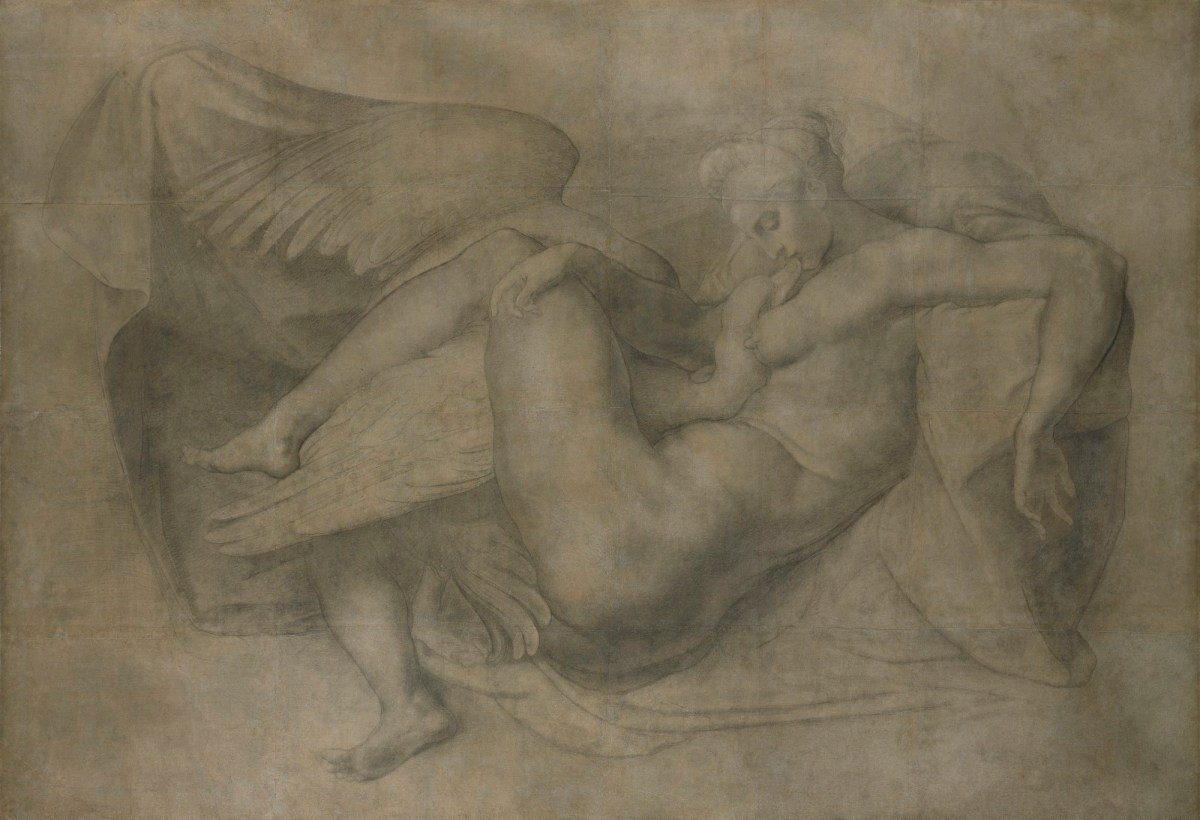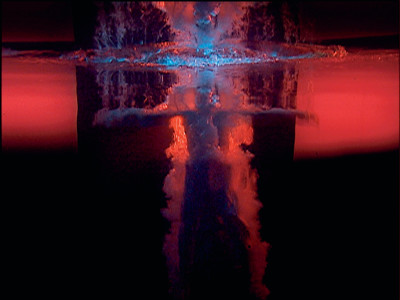
Unknown artist and Rosso Fiorentino and Michelangelo Buonarroti, Leda and the swan, mid 16th century.
Black chalk on paper. 1745 mm x 2538 mm. © Photo: Royal Academy of Arts, London. Photographer: Prudence Cuming Associates Limited.
This image is released under Creative Commons CC-BY-NC-ND
To licence this image for commercial purposes, contact our Picture Library at picturelibrary@royalacademy.org.uk
Leda and the swan, mid 16th century
Unknown artist and Attributed to Rosso Fiorentino (1494 - 1540) and Formerly attributed to Michelangelo Buonarroti (1475 - 1564)
RA Collection: Art
This imposing drawing depicts the mythical union of Leda, Queen of Sparta, with the god Jupiter in the form of a swan. It is one of the oldest and largest drawings in the Royal Academy Collection but its real fascination lies in the fact that it replicates a long-lost work by Michelangelo. It was once thought to be Michelangelo’s original ‘cartoon’ (a full-scale preparatory drawing) for the painting of Leda and the Swan he produced for Alfonso d'Este, Duke of Ferrara, in 1529-30. However, this attribution has since been challenged and the RA drawing is now thought to be a copy made by another 16th-century artist.
The history of Michelangelo's Leda, its cartoon and its copies, is complex. For reasons which remain obscure, the artist never delivered the painting to the Duke of Ferrara but instead sent it and its cartoon to France with his assistant, Antonio Mini. There is little solid evidence for the whereabouts of these works once they reached France but the Renaissance art historian Giorgio Vasari was probably correct in his claim that Michelangelo's Leda was acquired by King François I of France for his palace at Fontainebleau (see Falletti and Katz Nelson, Venere e Amore, exhibition catalogue, Florence 2002, cat. no. 17).
The Royal Academy's drawing is thought to have been made from Michelangelo's cartoon rather than his painting. It has been suggested that it could be the work of Rosso Fiorentino who was in France from 1530 to 1540 in the service of the King. Some scholars have doubted the logic of Rosso copying a work which was probably already in the French royal collection, but the high quality of drawing, along with Vasari's recollection that a cartoon of a Leda was found in Rosso's studio after his death, make this attribution a possibility (see Franklin, 'Rosso at the National Gallery of Art', Burlington Magazine, April 1988 and Falletti and Katz Nelson, 2002, cat. no. 17). As Vasari's reference could refer to a different composition, however, there is no documentary evidence to connect the RA drawing with Rosso and, if it was indeed produced in France, then it was soon after taken to Italy as it is recorded as being in Florence in 1568 (see below and Joannides, Drawings of Michelangelo, Cambridge, 2007, p. 34, n. 66).
Michelangelo's version of Leda and the Swan proved controversial and this possibly accounts for the disappearance of his original painting and cartoon. The painting is reputed to have been destroyed during the seventeenth century on the orders of Queen Anne of Austria because she objected to its 'lasciviousness'. An inventory of the French royal collection made in 1691 records this iconoclastic act as well as the existence of a drawing 'by Michelangelo representing a Leda' which was earmarked 'to be burned'. That drawing's absence from subsequent inventories suggests that it must have indeed been destroyed, sold or given away (see Carroll, Rosso Fiorentino, Drawings, Prints and Decorative Arts, Washington, 1987, cat. no. 102 and Falletti and Katz Nelson, 2002, cat. no. 17).
Attempts to identify the Royal Academy's Leda drawing with the one mentioned in the 1691 French royal inventory have recently been disproved, however (see Joannides, 2007, and Wickham, Burlington Magazine, May 2010). It has been shown that the cartoon was in the collection of Bernardo Vecchietti in Florence by 1568 and that it remained in the possession of this family until c. 1771 when it was bought by the English collector William Lock the Elder. He had the drawing shipped to London by 1773 and it later hung at his country estate, Norbury Park in Surrey.
When Lock died the drawing passed to his son, William Lock the Younger, who kept it in his study until plans to move abroad necessitated the sale of some of the family collection. Sir Thomas Lawrence, President of the RA and a friend of the Lock family as well as an obsessive collector of Old Master drawings, unsuccessfully attempted to persuade Lock to sell him the drawing for his own collection (RAA Ang/2 and Ang/3/1-2, letters from Sir Thomas Lawrence to Amelia Angerstein). Lock, however, refused and presented the cartoon to the Royal Academy where it was initially displayed in the RA Schools as an example to the students. When the institution moved to Burlington House later in the century, the drawing was hung in the General Assembly Room. The image remained contentious, however, and in 1877 two Academicians tried to have it ousted from the collection on the grounds that it was morally corrupting (General Assembly, March 21st 1877).
Related works:
The National Gallery in London has a painting after Michelangelo's cartoon of 'Leda and the Swan' by an unknown 16th-century artist
https://www.nationalgallery.org.uk/paintings/after-michelangelo-leda-and-the-swan. It is slightly smaller than the RA version and there are a number of small but significant differences in the pose of Leda. There is no particular evidence to indicate that the two are directly related. It has been suggested that the painting is also the work of Rosso Fiorentino but this has not been generally accepted.
The painting was acquired by the National Gallery in 1835 as part of a gift from the Duke of Northumberland who stipulated that it should not be put on public display because of its subject matter. The painting is thought to be the same copy of Michelangelo's Leda once owned by Sir Joshua Reynolds, P.R.A. He is said to have acquired this copy from Earl Spencer who decided to part with the painting after his young daughter, later the Duchess of Devonshire, embarrassed him by asking searching questions regarding the nature of the scene depicted.
William Etty painted a copy of 'Leda and the Swan' with the addition of a scene depicting two female bathers on the left hand side. This painting includes features of both the RA cartoon and the NG painting and may be a composite copy made from the two works which were presumably housed under the same roof between 1837 and 1867 (while the National Gallery and the Royal Academy shared premises). Etty's 'Leda' was auctioned at Christie's in 1966 (lot 166, 18th November) and 1968 (lot 5, 22nd March) but is currently untraced.
Further reading:
Eugene A. Carroll, Rosso Fiorentino Drawings, Prints and Decorative Arts, National Gallery of Art, Washington, 1987, cat. 102
Franca Falletti and Jonathan Katz Nelson eds.,Venere e Amore - Michelangelo e la nuova bellezza ideale, exh. cat., Accademia di Belli Arte, Florence, 2002, cat. 17
David Franklin, 'Rosso at the National Gallery of Art, Washington',Burlington Magazine, April 1988, pp. 323-326
Kenneth Garlick, ‘Lock, William (1732–1810)’, Oxford Dictionary of National Biography, Oxford University Press, 2004
Paul Joannides, The Drawings of Michelangelo and his Followers in the Ashmolean Museum, Cambridge, 2007, p. 34
Annette Wickham, ‘Thomas Lawrence and the Royal Academy’s cartoon of ‘Leda and the swan’ after Michelangelo’, Burlington Magazine, May 2010, pp. 297-302
Object details
1745 mm x 2538 mm
Start exploring the RA Collection
- Explore art works, paint-smeared palettes, scribbled letters and more...
- Artists and architects have run the RA for 250 years.
Our Collection is a record of them.


